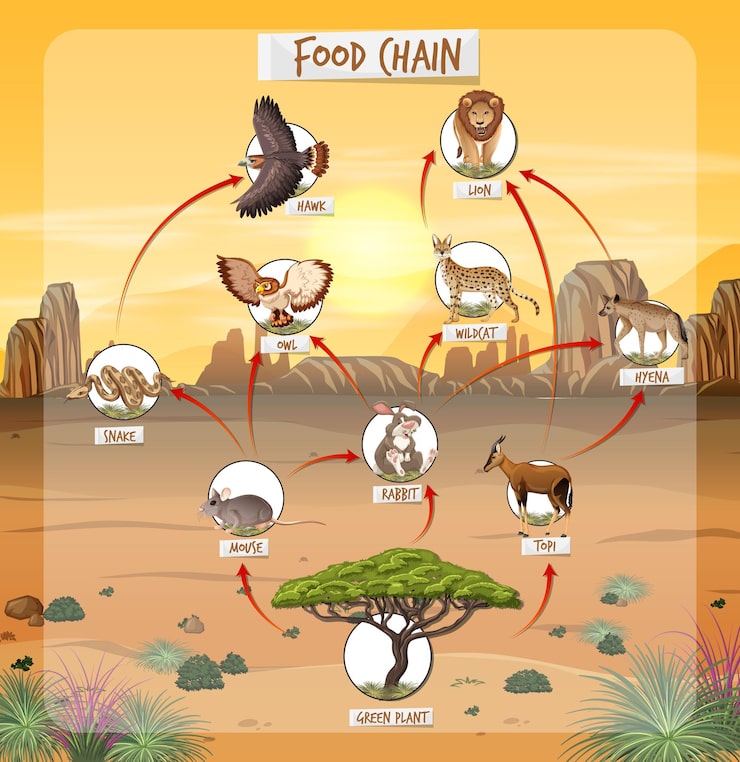Introduction
It is said that the Desert food web is among the natural world’s most intriguing survival systems. Unlike lush forests or wetlands, deserts present extreme challenges–scorching heat, little water, and limited vegetation. However, life is thriving here thanks to a delicate balance between consumers, producers and decomposers. The understanding of how the food web of the desert allows us to see the way energy flows between plants, herbivores carnivores, as well as scavengers eventually keeping the ecosystem balanced.
This guide will examine what’s known as the food web within the desert and provide instances from the major deserts such as Sahara, Mojave Sonoran, Mojave, and Sahara and address the most frequently asked questions about the ways plant and animal species in deserts can survive.
What is a Desert Food Web?
The food web found in the desert ecosystems is a system of food relationships that show how energy flows between living things. Contrary to a traditional food chain one can see numerous connections because most animals consume several kinds of food.
- Producers (plants or shrubs, Cacti) absorb sunlight and store it as energy.
- Primarily consumers (insects rodents, insects, herbivores) consume plants.
- Secondary and Tertiary consumers (lizards, snakes hawks, foxes) hunt herbivores and other carnivores.
- The decomposers (fungi bacteria, fungi, scavengers similar to the vultures) reuse nutrients into soil.

This balance is essential since any disturbance, such as disappearance of predators or vegetation–can alter the whole food web that comes from to the desert.
Key Producers in the Desert Food Web
Without producers and consumers, there would not be a food web. Plants in deserts have evolved to endure in dry, hot environments by conserving water and reducing the amount of water that evaporates.
Examples of Desert Producers:
- Cacti (Saguaro, Prickly Pear) Store the water in stems, and provide an environment for shelter and food.
- Creosote The Bush extremely drought-resistant leaves are a source of food for insects.
- Mesquite trees Deep roots tap groundwater Seeds provide food to birds and rodents.
- Desert Grasses – the growth of grasses during the season is beneficial to herbivores.
They are the basis for the diet of the desert since the sun’s energy is converted into sunlight which is used to support all higher living organisms.
Primary Consumers in a Desert
The primary consumers are herbivores as well as Omnivores who eat seeds, desert plants and even fruits.
Examples of Primary Consumers:
- KANGROO RATS consume seeds and plant matter, and also serve as prey to snakes.
- Desert Tortoises – feed on cactus and grass pads.
- insects (Grasshoppers, Beetles, Ants) – eat plant matter, which is essential for high consumer.
- Jackrabbits Feed on grasses and shrubs.
The species are able to transmit energy from plants up through the food web of the desert.
Secondary Consumers in the Desert
Secondary consumers eat herbivores to maintain balance in the population.
Examples:
- Lizards (Collared Lizards, Desert Iguanas) They eat insects as well as smaller reptiles.
- Snakes (Rattlesnakes, Gopher Snakes) prey on rodents, birds and Lizards.
- Coyotes are predators that are opportunistic in their feeding habits, consuming rabbits insects, as well as fruits.
- Roadrunners are fast birds that feed on snakes, lizards and other insects.
Tertiary Consumers and Apex Predators
The very top of the food chain in the desert are carnivores, which help keep ecosystems balanced by controlling population.
Examples:
- Golden Eagles & Hawks Prey on snakes, rodents, and rabbits.
- Bobcats & Mountain Lions Hunt jackrabbits, deer, and other smaller predators.
- Owls are nocturnal hunters that feed on rodents as well as insects.
These predators are less likely to have natural enemies, and are essential to stabilizing ecosystems in deserts.
Decomposers: Nature’s Recyclers
There is no food web in ecological deserts can be complete without the decomposers. They decompose dead animals and plants recycling nutrients back to the soil.
Examples:
- Fungi & Bacteria – decompose organic material.
- Scavengers (Vultures, Beetles, Ants) – consume dead animals.
- Termites Recycle plant matter into nutrient.
Without decomposers energy flow would cease and deserts wouldn’t be able to keep life going.
Example: Food Web in the Sonoran Desert
Let’s sketch out a concrete illustration of the food web that is suitable for deserts within the USA (Sonoran Desert):
- Producers: Cactus, Mesquite, Creosote Bush
- Primary Consumers: Kangaroo Rat, Desert Tortoise, Grasshoppers
- Secondary Consumers: Rattlesnake, Roadrunner, Lizards
- Tertiary Consumers: Golden Eagle, Coyote, Bobcat
- Decomposers: Vultures, Fungi, Bacteria
The interconnected system will ensure that it will survive even in the most extreme conditions.
How Human Activity Impacts the Desert Food Web
The fragile balance in the food web in deserts is becoming increasingly impacted through human activities:
- Urban Expansion – reduces natural habitats.
- Climate Change – alters the pattern of rainfall, which could be dangerous to the vegetation.
- Ingrazing caused by livestock reduces native plant populations.
- The polluting & Mining – pollutes the soil as well as water.
If predators or producers are eliminated and the ripple effects are weakened, it destabilizes the whole food web that is derived from in the desert.
FAQs About the Desert Food Web
1. What is the most basic food web that can be used in the desert?
A simple food web in the desert begins with plants (like Cactus) and is followed by herbivores (like rats from kangaroos) followed by predators (like snakes and hawks) and then the decomposers (like mushrooms).
2. What role play cacti in the food web of deserts?
Cacti serve as food as well as shelter for many desert animals, which makes them vital contributors to the ecosystem.
3. What are some of the best predators of desert ecosystems?
Golden eagles, coyotes mountain lions and bobcats are the top predators throughout North American deserts.
4. How can a food web in an area of desert differ from rainforest?
Rainforests are a rich biodiversity area with thick canopies, while deserts are less adapting to extreme dryness and heat.
5. What is the significance of decomposers to the environment of deserts?
Decomposers reuse nutrients back into soil which allows plants to grow and re-start the food chain.
Conclusion
The food web of the desert is an excellent illustration of the resilience of nature. From cacti that hold water to hawks that fly above, every living thing plays an important role in the transfer of energy and balance in ecosystems. When we study the food web in desert ecosystems and understanding how life evolves in extreme environments, and why safeguarding the fragile ecosystems is important.
If we protect producers, guard against predators, and minimize human interference deserts will continue flourish as living ecosystems instead of deserts that are barren.





